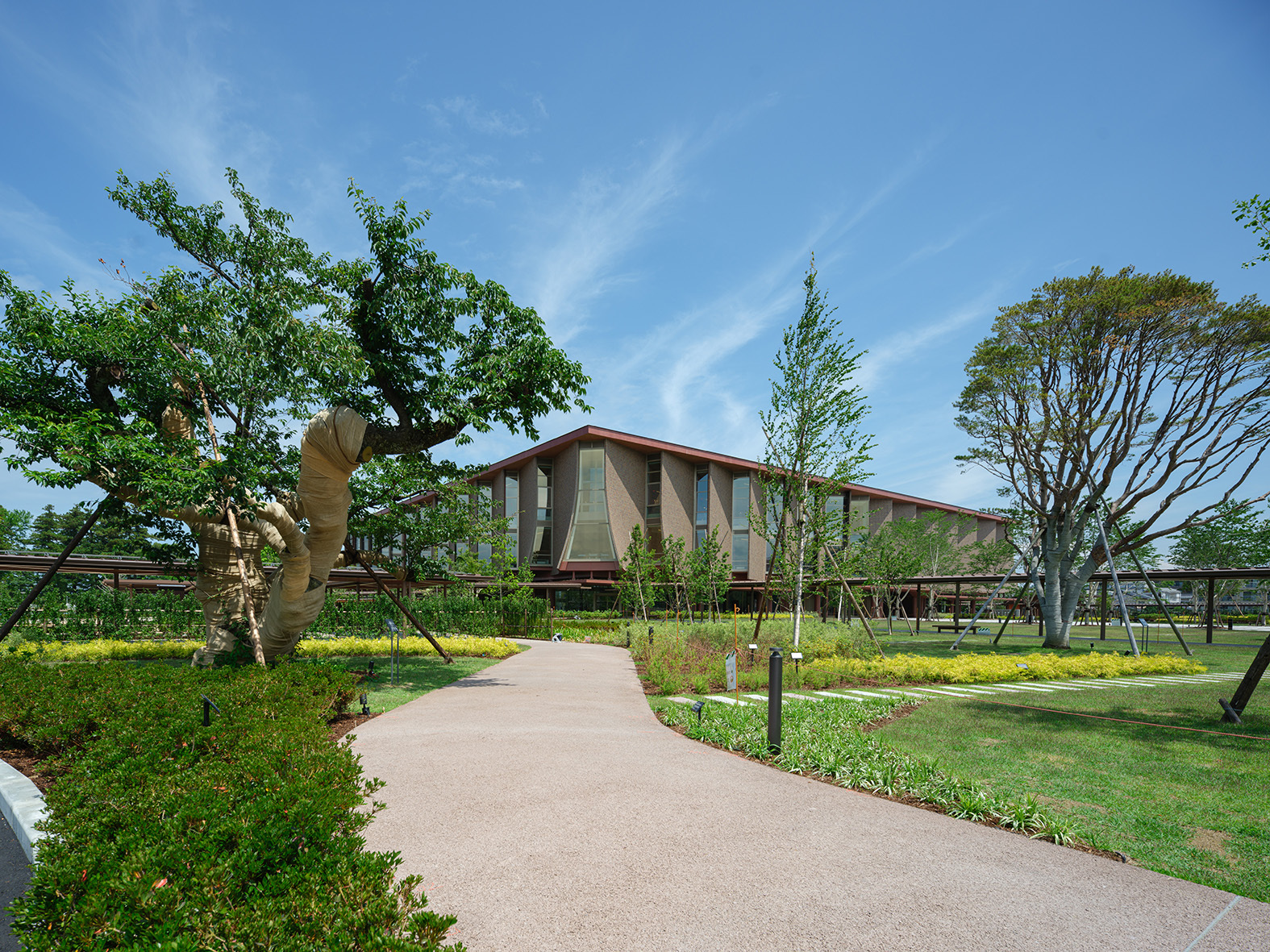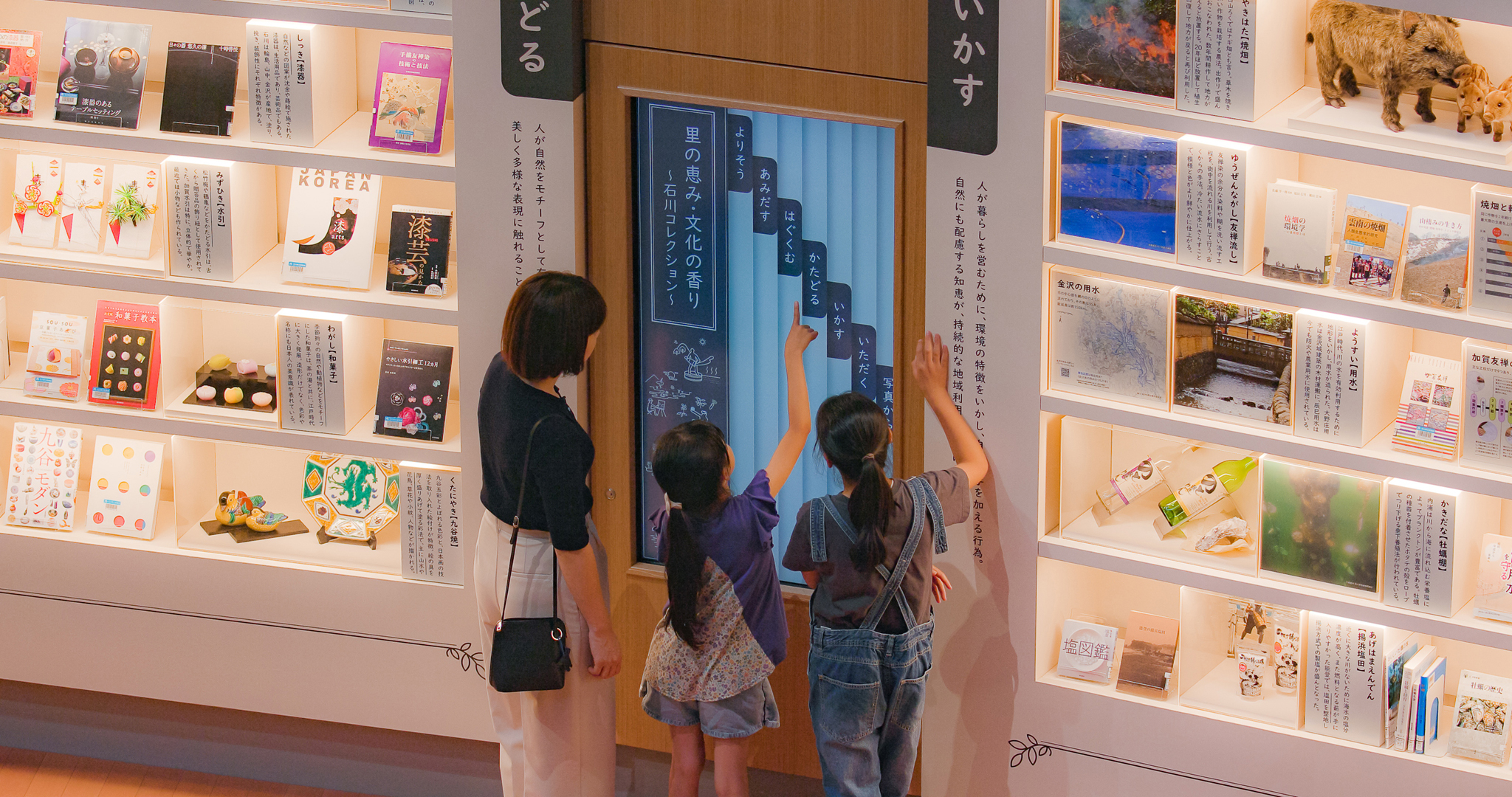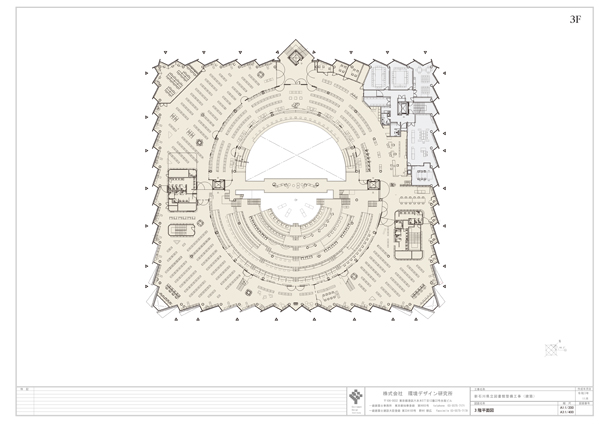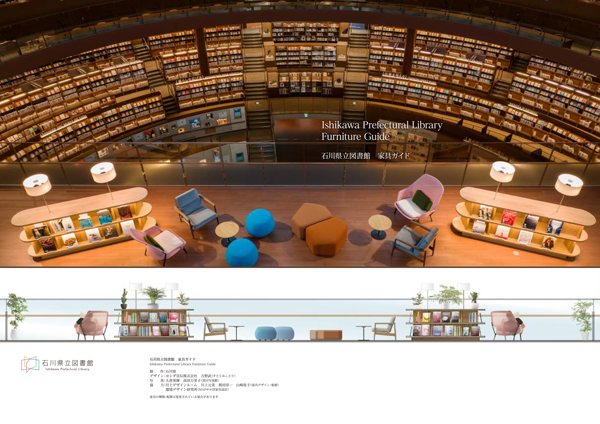Welcome to Ishikawa Prefectural Library

Ishikawa Prefectural Library strives to be a haven where you can turn a page of your life through serendipitous encounters with books and a plethora of diverse experiences.
Our library houses 300,000 books to choose from, offers 500 reading seats, where you can spend your time as you please, and has a lively intellectual atmosphere that fosters discussion and exchange. It is a vibrant hub of endless possibilities, where you can immerse yourself in an array of literature and ideas.
We are committed to providing a diverse range of encounters to all individuals.
1. 6 features

(1) Interaction with the surroundings and local culture
Our library is situated in the heart of Ishikawa Prefecture, which is almost at the geographical center of Japan. As a prefectural establishment, we aim to welcome people from all over the prefecture and have recently constructed a new road connecting the library with the main highway that runs north to south through the prefecture.
The library serves as a cultural and educational hub, nestled within a region rich with institutions such as art galleries, museums, music halls, a Noh theater, elementary and high schools, and universities. It showcases museum collections and works by art university students, hosts local orchestra concerts, and holds classes for elementary school students. By facilitating these activities, the library helps to cultivate a vibrant and intellectually stimulating community. Supported by the local government of Ishikawa Prefecture and its governor, the library has one of the largest budgets for material collection among municipalities.
The library building was designed to blend into the natural surroundings with a low height of 15 meters and incorporates green spaces and trees. Visitors can enjoy a park-like environment in which to relax, chat, or read.
Our library is a large-scale facility that boasts an extensive collection of approximately 1.5 million materials, including one million books that cater to diverse ages and needs, ranging from readable to specialized ones. As a result, conversations are allowed in almost all areas of the building, making it a bustling hub of activity.
Ishikawa Prefecture is renowned for its rich cultural heritage, which has been passed down for over 400 years since the samurai era. This cultural legacy encompasses a diverse range of art forms, including Noh theater, traditional crafts, tea ceremony, and flower arrangement. In addition, the region's unique history and climate have contributed to the development of distinctive festivals and cuisine. Moreover, the prefecture boasts a wealth of high-quality cultural offerings, including the innovative Orchestra Ensemble Kanazawa. The area's natural environment is equally noteworthy, with its Satoyama Satoumi resources being internationally recognized as a Globally Important Agricultural Heritage System (GIAHS) by the United Nations Food and Agriculture Organization (FAO). As a library, we take pride in our extensive collection and accessible display of materials that preserve and disseminate the region's rich culture.
As a prefecture, which functions as a higher-level municipal body, we place significant importance on the comprehensive collection of region-specific materials. To encourage residents to take an interest in and learn about the local culture and attractions, we have appointed subject librarians with extensive knowledge of the region. As a result, our establishment has become a model for libraries in lower-level municipal bodies, which comprise cities, towns, and villages.
Our grand opening in July 2022 made headlines in Japan after a visitor's post went viral on Twitter, receiving almost 250,000 likes. Our daily events are covered extensively in local newspapers, drawing visitors from not only the prefecture but also from different parts of Japan and overseas.
(2) Architectural Quality
The library's striking design, featuring alternating exterior walls and glass, evokes the feeling of "flipping through the pages of a book", which effectively conveys its purpose. The building has been functionally divided into three areas: Main Library Area dedicated to housing books; Activity Area designed to offer a range of engaging experiences; and Children's Area aimed at providing a fun space for children to play and explore.
Main Library Area boasts an amphitheater-like space, surrounded by circular bookshelves arranged in tiers. In the atrium, visitors find themselves encircled by books from all directions, with soft natural light filtering down from above. Together with the lighting throughout the building, the library is bathed in a soft glow while avoiding direct sunlight on the books. The building's lighting casts a warm and inviting glow at night, offering a charming and friendly nighttime view that is cherished by the community. On the third floor, the "Bridge" runs through a circular space, creating a symbolic area where visitors can view all of the circular bookshelves in every direction.
Children’s Area has seating and bookshelves arranged like playground equipment with height differences, allowing children to move and read at the same time. They can also take books to Narrative Forest, an outdoor reading space. Architectural features have been added to ensure that loud voices or crying in Children’s Area are not heard in Main Library Area.
Activity Area has been thoughtfully designed to serve as the vibrant heart of the community. With a stepped hall, training room, makerspace, kitchen space, and other essential facilities, it offers a diverse range of activities and experiences beyond simply reading. As a result, the library has transformed into a thriving cultural establishment.
The library has over 500 seats and a variety of exquisite chairs and furniture from around the world, carefully curated by furniture designers. Visitors can effortlessly admire the art and design showcased at the facility. The seats near the windows are arranged individually, providing a breathtaking view of the surrounding scenery from each of the approximately 50 spots. This is made possible by the alternating arrangement of wall panels and large glass windows on the exterior wall, which creates a study-like atmosphere.
Even in a bustling library where visitors can have conversations, we still have a quiet space called the Silent Reading Room. In this way, we cater to everyone's needs with various areas, including busy and quiet spaces, well-lit areas for studying, and dimly-lit calming spaces.
The library was built with universal design principles in mind, to ensure it is accessible to everyone. From the early stages of architectural planning, we worked closely with people with disabilities, incorporating their feedback to create models of the furniture and repeatedly conducting accessibility checks. We also ensured that all areas are wheelchair and stroller accessible and considered various other aspects of accessibility, such as installing easy-to-grip handrails on slopes and placing chairs nearby.
Overall, our establishment represents the culmination of various efforts to create a library that people of all ages will want to visit time and time again.
(3) Flexibility
We ensured that the library was designed with flexibility in mind, anticipating its use for at least the next 50 years and beyond.
The spacious outdoor square can be connected to the indoor entrance foyer by opening the large glass panels on the front of the building, allowing for events such as farmers' markets selling locally cultivated vegetables and fruits.
The stepped hall has a seating capacity of 140 and can be closed off to host lectures and music recitals. However, it can also be used in combination with the adjacent entrance hall by removing the surrounding partitions.
The training room can be divided into halves or quarters to accommodate workshops of different sizes.
In the makerspace, visitors can learn about programming and crafts using the latest equipment such as 3D printers. Seats are also provided in the surrounding space to host expanded events.
The kitchen space can be used for food-related events and also science experiments using water and other scientific events.
The learning space is a flexible area in which users are free to move tables to accommodate individual or group study, workshops for about 20 participants, and various exhibitions.
As part of the library, Activity Area offers a whole range of events, learning opportunities, and hands-on experiences in humanities, natural sciences, and other fields, including music recitals, botanical and zoological learning events, and speeches by authors. Since its inception, the library has been a vibrant and bustling hub of community activity, known to residents as a place where something interesting is always happening whenever they visit.
Main Library Area contains 70,000 books that are not sorted under the Dewey Decimal Classification system. This permits the flexible arrangement of books and non-book materials by theme, without any restrictions. Additionally, visitors can find books covering current global events, news, and trends arranged alongside their respective topics.
Main Library Area features a special exhibit section where thematic displays are presented using panels, models, and various materials. The exhibits are changed three times a year, providing a flexible and dynamic experience for visitors. During the grand opening, the section showcased easily accessible exhibits that incorporated picture books related to dinosaurs and evolution. Subsequent exhibits featured literary works in conjunction with Japanese games and anime culture, both of which garnered a significant number of visitors.

(4) Sustainability
The library's flooring, ceiling, bookshelves, and other components are constructed from wood, with approximately 80% of the wood sourced locally. We also have a unique piano crafted from local wood that visitors can freely play, providing an opportunity to learn about sustainability. Even the café employs local wood for its interior, tables, and trays.
The outdoor square, spanning 1,000 square meters, is surfaced with locally sourced stone and recycled industrial waste from neighboring businesses. These materials store rainwater, helping to mitigate the heat island effect. Our eco-friendly library employs various sustainable practices. These include collecting rainwater for toilet flushing, the use of solar panels for energy, and a geothermal heating and cooling system to save electricity.
In 2010, Japan hosted the 10th Conference of the Parties to the Convention on Biological Diversity (COP10). As Ishikawa Prefecture is deeply involved in COP10, its governor attended the conference. Meanwhile, the prefecture hosted the closing ceremony of the International Year of Biodiversity designated by the United Nations. In this way, the local government of Ishikawa Prefecture strongly promotes measures for biodiversity and the realization of a sustainable society. To support this effort, we curate a collection of books and examples on the topic from Ishikawa, other parts of Japan, and around the world, and present them in an easily accessible and understandable format. Our exhibits provide valuable learning opportunities for users who share our goal of realizing a sustainable society.
Narrative Forest in Children's Area recreates Satoyama, designated a Globally Important Agricultural Heritage System by the Food and Agriculture Organization of the United Nations (FAO-GIAHS), and provides children with agricultural experiences. It offers a unique opportunity to learn and gain agricultural experiences in a library, as such resources are not readily available elsewhere in the world.
(5) Learning & social connection
At our library, we strive to create a welcoming space that is accessible to everyone in the local community and society. To achieve this goal, we have developed a unique way of organizing our books to promote reading for all, even those who do not read regularly. Approximately 70,000 books in Main Library Area are uniquely classified according to 12 themes that are familiar and relevant to residents, such as "Think about work" and "Broadening your lifestyle." This approach is a departure from the Dewey Decimal Classification system. In the center of the library, we display readable books with their front covers facing visitors.
To showcase our 12 themes, we created window-like bookshelves that emulate the joy of window shopping. We incorporated playful elements such as toys to add a touch of fun and entice visitors to pick up the books. Additionally, each of our librarians contributed their ideas for a book, which has helped us cultivate a reputation as a library where learning is enjoyable. Our efforts have proven successful, as we have seen a fivefold increase in the number of books borrowed compared to our previous library setup.
Activity Area is open to everyone as an event space for rental. It is used for various cultural activities and exchanges that welcome all members of society, including regular concerts by local orchestras, book clubs, and private companies' sales events. The library's extensive collection of books adds depth and richness to the events, facilitating better learning through the synergistic effect of shared experiences and knowledge.
In addition to our collection of over one million books, the establishment serves multiple roles beyond that of a typical library, responding to social needs. We pride ourselves on being a storage center for valuable materials and administrative documents of Ishikawa Prefecture. We are also able to direct the movement of books between municipalities.
Furthermore, we take the lead in promoting the smooth operation of the local economy by attracting events that highlight private companies, including farmers' markets selling locally harvested vegetables and fruits, cooking events that utilize them, and the development and sale of menu items in the café. When there are no such events, each space in Activity Area is open and available for use as a study space by local students and businesspeople.
Our library serves as a platform for highlighting the rich cultural heritage of our local designers. Throughout the building, visitors will find rotating exhibits of artwork and traditional crafts in showcases, offering a unique opportunity to experience the region's design and traditional culture. Main Library Area contains a diverse collection of books, including non-Japanese titles, making our library accessible to everyone. We take pride in offering a safe and inclusive space, with a broad range of books suitable for children, the elderly, people with disabilities, and international visitors. Our collection includes all children's, easy-to-read, and large-print books published in Japan. Moreover, we are committed to supporting schools in Ishikawa Prefecture. We have a dedicated collection of books available for lending to elementary and junior high schools, supplementing their own libraries.
We also strive to ensure that our learning and other spaces complement each other. In the makerspace, visitors can create bookmarks using their favorite phrases from books they find in Main Library Area.
Consequently, our library functions as a "place to belong" for all members of the local community. Many dedicated volunteers have been attracted to this environment and feel a great sense of fulfillment in contributing to such a meaningful cause.
(6) Digitisation & technical solutions
Ishikawa Prefectural Library has released a groundbreaking system called SHOSHO, which provides total support for people to "search","access",and "utilize"the library contents. The library’s role is to offer knowledge and help people turn to the next page of their lives, which requires more than a simple search system.
SHOSHO enables users to explore the library’s vast collection of over 1 million resources using more than 15 different methods, including user-friendly and entertaining search options, and theme-based searching. It serves all ages and scholars, providing a wide range of content based on diverse needs.
SHOSHO aids in accessing library materials. It offers clear directions to books on shelves and enables the ordering of items from the backroom. Even if distance or a busy schedule prevents a library visit, items can be sent to a library near your home or workplace.
On your PC or mobile device, you can easily view or download digital content images. You can also arrange content in your favorite layout and add text to create blogs or work materials.
At our makerspace, you can create your own creations using library contentsSHOSHO's beautiful and functional design was achieved through collaboration between IT engineers, designers, and accessibility experts, catering to the diverse needs of its users.
In summary, SHOSHO helps you take the next step by encountering and experiencing our content.
2. SDGs, IFLA's Global vision

At Narrative Forest located in Children's Area, we provide children with an opportunity to cultivate the unique varieties of crops found in Ishikawa Prefecture.
※SDGs [2.4]
We have assembled a vast array of materials on biodiversity and the Globally Important Agricultural Heritage Systems (GIAHS) of the Food and Agriculture Organization of the United Nations (FAO), which we use to create engaging and accessible displays that provide our community with valuable learning opportunities in these important fields.
※SDGs [2.4][11.4][14][15] Global Vision [10hl-2]
To cater to the requirements of children, we bring together all children's books published in Japan.
※SDGs[4.a] Global Vision [10hl-6]
We have installed a rainwater reuse system that enables us to use rainwater for toilet flushing and other purposes.
※SDGs [6.4]
We contribute to the reduction of CO2 emissions with the use of solar power generation and a cooling and heating support system that circulates air through the seismic isolation layer that exists underground and suppresses earthquake tremors.
※SDGs [7.2]
Our commitment to promoting sustainable forestry in the world is reflected in the construction of our library, where 80% of the wood used was sourced from Ishikawa Prefecture. Additionally, we have made extensive use of locally sourced timber in the interior design of the library's café. Even the piano in the entrance hall is made of local timber, and visitors are free to play it. These initiatives are widely publicized through panels, aimed at educating local citizens.
※SDGs [12.2][15.4]
The outdoor square contains recycled concrete made from industrial waste.
※SDGs [12.5]
We digitize valuable materials that can only be seen inside our library and make them available for viewing from anywhere in the world. We have also independently developed a system that allows for the collective searching of books, magazines, official documents, digital materials, and more.
※SDGs[16.10] Global Vision [10opp-1, 2, 9]
We believe in collaborative initiatives and work closely with all stakeholders to promote community engagement. Our efforts include organizing farmers' markets in partnership with agricultural organizations, hosting mini-concerts featuring local orchestras, partnering with local universities to offer courses for residents, and facilitating library and railway events in collaboration with local train operators.
※SDGs[17.17] Global Vision [10opp-6]
We warmly welcome visitors from all over Japan and around the world to exchange ideas with us, and occasionally participate in joint training programs, enabling us to enhance our skills and broaden our perspectives beyond the boundaries of our local community.
※Global Vision [10hl-7]
3. Pictures
4. Floor plans / Furniture layout / Architectural drawings

>> Drawings (pdf 8,679kb)
>> Furniture Guide (pdf 4,622kb)
5. Movie
6. User's guide
- トップページ
- SPACE
- 石川県立図書館について
- Welcome to Ishikawa Prefectural Library


